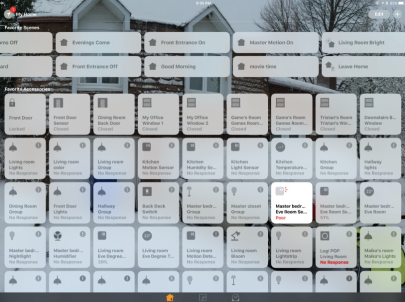Elevators Vs. Networks: Applying Predictive Analytics
Could predictive analytics help foresee network failures?
Could predictive analytics help foresee network failures?
 Enterprises looking to deploy containers are struggling with connectivity challenges.
Enterprises looking to deploy containers are struggling with connectivity challenges.
The post Worth Reading: Ageism in technology appeared first on rule 11 reader.
As many of you know, I’ve been diving into the home automation pond for awhile now. I’ve been asked to blog out my current home setup and this is an attempt to do that. There’s MUCH too much to be put into a single post, which is why I started a new blog for this subject over at www.homekitgeek.com as well as doing some video reviews of different HomeKit accessories. Work in process, but I’ll do the short version here.

![]()
I chose to use the Apple homeKit framework as the base for my home automation journey for a few reason. The biggest one is that I already owned a couple of Apple TV (gen4) devices which fit the home automation hub role. These devices are a homeKit hub and are the always-on/always-present devices that are used to perform orchestration/automation actions when I’m home or away. These also tie directly into Apple’s iCloud which allows me remote access to my homeKit gear without having to VPN into my home network.
There’s a lot to talk about here, but I thought I would just do a quick description of what’s going on room-by-room Continue reading
 Equinix already offers direct connectivity to AWS, Microsoft Azure, Oracle Cloud, Google Cloud Platform, and IBM Bluemix.
Equinix already offers direct connectivity to AWS, Microsoft Azure, Oracle Cloud, Google Cloud Platform, and IBM Bluemix.
In the IT business, just like any other business, you have to try to sell what is on the truck, not what is planned to be coming out of the factories in the coming months and years. AMD has put a very good X86 server processor into the market for the first time in nine years, and it also has a matching GPU that gives its OEM and ODM partners a credible alternative for HPC and AI workload to the combination of Intel Xeons and Nvidia Teslas that dominate hybrid computing these days.
There are some pretty important caveats to …
The Shape Of AMD HPC And AI Iron To Come was written by Timothy Prickett Morgan at The Next Platform.
The post The Knowledge Mortgage appeared first on rule 11 reader.
Google has been at the bleeding edge of AI hardware development with the arrival of its TPU and other system-scale modifications to make large-scale neural network processing efficient and fast.
But just as these developments come to fruition, advances in trimmed-down deep learning could move many more machine learning training and inference operations out of the datacenter and into your palm.
Although it might be natural to think the reason that neural networks cannot be processed on devices like smartphones is because of limited CPU power, the real challenge lies in the vastness of the model sizes and hardware memory …
Google Research Pushing Neural Networks Out of the Datacenter was written by Nicole Hemsoth at The Next Platform.
 Platform can support Kubernetes-based container deployment in 10 minutes.
Platform can support Kubernetes-based container deployment in 10 minutes.
The post Worth Reading: A code camps getting the boot? appeared first on rule 11 reader.
Novel architectures are born out of necessity and for some applications, including molecular dynamics, there have been endless attempts to push parallel performance.
In this area, there are already numerous approaches to acceleration. At the highest end is the custom ASIC-driven Anton machine from D.E. Shaw, which is the fastest system, but certainly not the cheapest. On the more accessible accelerators side are Tesla GPUs for accelerating highly parallel parts of the workload—and increasingly, FPGAs are being considered for boosting the performance of major molecular dynamics applications, most notably GROMACS as well as general purpose, high-end CPUs (Knights Landing …
A MapReduce Accelerator to Tackle Molecular Dynamics was written by Nicole Hemsoth at The Next Platform.
It’s amazing how long it can take to get some sanity into networking technologies. RFC 8212 specifies that a BGP router should not announce prefixes over EBGP until its routing policy has been explicitly configured. It took us only 22 years to get there…
For more technical details, read this email by Job Snijders.
 What the modern MNO will need is a virtualized mobile core.
What the modern MNO will need is a virtualized mobile core.